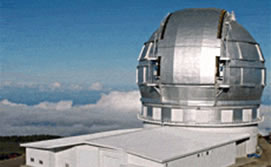Astrophysicists from the Complutense University of Madrid (UCM) are leading the development of what will be the next optical instrument for the Gran Telescopio Canarias: The MEGARA spectrograph. On September 30th the committee responsible for the Gran Telescopio Canarias (GTC)—which has a primary mirror more than 10 meters in diameter and is the world’s largest optical/infrared telescope—announced that the MEGARA spectrograph had been selected for the design phase and future construction of the GTC’s next optical instrument.
MEGARA will be built by a consortium of Spanish and Mexican institutions, led by researchers from the UCM’s Extragalactic Astrophysics and Astronomic Instrumentation Group, of the Department of Astrophysics and Atmospheric Sciences at the Complutense University of Madrid. Also in the consortium are the Andalusia Astrophysics Institute and Mexico’s National Institute for Astrophysics, Optics and Electronics (INAOE).
 A spectrograph separates white light into its different component colors (or energies), with much greater detail than is possible using color filters in photography. MEGARA is extremely precise when it comes to studying the electromagnetic spectrum of celestial bodies, and enables scientists to determine many of the properties of the stars and gas which make up the galaxies. For example, the color of stars is a good indicator of their mass, using the general rule that heavier stars are bluer.
A spectrograph separates white light into its different component colors (or energies), with much greater detail than is possible using color filters in photography. MEGARA is extremely precise when it comes to studying the electromagnetic spectrum of celestial bodies, and enables scientists to determine many of the properties of the stars and gas which make up the galaxies. For example, the color of stars is a good indicator of their mass, using the general rule that heavier stars are bluer.
When it begins operating, expected in 2015, MEGARA will weigh over one and a half tons, representing latest generation technology in an apparatus the size of a small car. The cost of MEGARA in its most basic configuration is estimated at about €4 million.